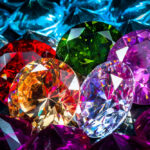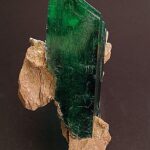Short answer: Different gems for engagement rings include diamonds, sapphires, rubies, emeralds, and other precious stones. Each gemstone carries its own symbolism and meaning, making it a personal choice for the couple. It is important to choose a high-quality stone with good cut, clarity, and color when selecting an engagement ring.
How to Choose the Perfect Gemstone for Your Engagement Ring
Engagement rings are a symbol of lasting love and commitment between couples. It’s only natural that many people want to make their proposal as special as possible by giving the perfect engagement ring – one that speaks volumes about their relationship and their future together.
One essential element of an engagement ring is, of course, the stone. There are so many gemstones available out there, ranging from diamonds to sapphires, rubies to emeralds. But how do you choose the ideal stone for your engagement ring?
Here’s a guide on how to select the perfect gemstone for your engagement ring.
1) The 4Cs
The 4Cs—Color, Clarity, Carat Weight, and Cut—are important factors in choosing a diamond for an engagement ring. Diamond color can range from D (colorless) all the way to Z (yellowish/brown). Clarity measures any imperfections or blemishes within a diamond. Carat weight refers to the size of the diamond while cut determines its brilliance and sparkle.
2) Budget
Gemstones vary greatly in price which means budget has an important role in deciding what type of stone suits best. If you’re interested in diamonds but not keen on breaking the bank then consider going down slightly lower on carat weight or selecting stones with fewer frills such black or salt-and-pepper diamonds- whilst still retaining confidence that these offer excellent durability over time.
3) Personal preferences
It really depends if you’re looking for something traditional and timeless like white diamonds versus something more unique such as opal – this would be entirely up personal taste! Make sure whatever choice is made reflects both partners’ tastes together so they’ll treasure it forevermore!
4) Setting
Finally when deciding what gems may work best first think about setting options: Would pave look stunningly beautiful? Cluster settings quite charming? Or simple solitaires better suited? This decision will set the tone for the stone you choose and can also go hand in hand with budget constraints.
Choosing the perfect gemstone is an important part of creating a memorable engagement ring. Take your time, weigh up all options so that the one chosen matches what you’re looking for exactly! It has to be something that makes both partners feel special at this momentous stage in their lives whilst showcasing their shared future together – here’s hoping they love it!
Step-by-Step Guide to Finding the Best Gemstones for Your Engagement Ring
When it comes to choosing an engagement ring, the gemstone plays a significant role in making your loved one say “yes” with all their heart. Choosing the perfect gem for your partner is critical since it will reflect their personality and style. From classic solitaires to stunning halo designs, there are endless choices that can bewilder you.
If you’re looking for guidance on how to choose the right stone, this step-by-step guide can help you make an informed decision:
1) Set Your Budget
Before delving into purchasing an engagement ring’s gem, setting a budget is crucial. The price of a diamond or other precious stones varies based on several factors like color, size, and quality. Keep in mind that while getting affordable gems may seem tempting initially, investing more in high-quality stones will ultimately pay off.
2) Learn about Gemstones
Take some time researching various types of precious stones available so that when visiting jewelry stores, you know what to expect. Sapphires and rubies showcase beautiful hues of blue and red shades respectively – they might not be traditional options but still hold quite similar appeal as diamonds.
3) Look at Different Collections
Different collections contain varying styles showcasing unique arrangements of stones mounted alongside interesting diamonds’ cuts. Explore different designer brands containing remarkable engagement rings showing exceptional gemstones complemented by intricate settings.
4) A Quality Cut Matters
Gemstones follow precise cutting techniques contributing both visually appealing aspects along with durability purposes essential throughout continuous daily wear-and-tear engagements over time.
5) Determine Ring Size & Shape
A vital aspect during picking out any piece of jewelry requires ensuring its proper fit- even if trying to keep everything under wraps until proposing! Knowing exact measurements facilitates less hassle throughout exchange processes along with increasing assurance-levels making sure the recipient has no worries regarding accidental loss/other related concerns after accepting your gesture
6) Personal Preferences Matter!
Don’t forget: Ultimately it boils down to person gender likes/dislikes- after all, they will be wearing the ring regularly moving forward! Consider colors, carat size preferences and particular symbolism attached carrying special meaning from significant events in one’s life.
In conclusion, finding your dream engagement ring with perfect gemstones takes time and effort but is worth it. By following these simple steps guaranteed to assist selecting an impressive piece tailored specifically for that someone special. Choosing a timeless style doesn’t merely signify momentary love-it symbolizes sustenance within building lasting partnerships throughout future years together being tastefully stylish as well!.
Frequently Asked Questions About Different Gems for Engagement Rings
Engagement rings are a symbol of love, commitment and promise to spend the rest of your life with someone special. And what better way to showcase that love than by adding a stunning gemstone sparkling on top of it? But when it comes to choosing engagement rings, there may be some confusion about different types of gems available in the market. To help you make an informed decision, we have put together a comprehensive list of frequently asked questions about different gems for engagement rings.
Q: What is the most popular gemstone for an engagement ring?
A: A diamond is typically considered as the go-to gemstone for engagement rings. Not only does it symbolize eternal love but also clarity and purity. However, modern couples are increasingly choosing personalized stones like sapphires or rubies to tailor their unique color preferences.
Q: Are colored gemstones suitable for an engagement ring?
A: Absolutely! Colored gemstones can add a pop of personality and uniqueness compared to traditional diamonds. The choice ultimately relies upon personal preferences, although vibrant colored choices such as blue sapphire or emerald green work well in complementing contemporary designs.
Q : What are precious vs semi-precious stones?
A: Gemstones traditionally categorized into two categories – precious and semi-precious stones. This categorization merely reflects rarity and demand from customers – this doesn’t determine quality; so many high-quality ‘semi-precious’ minerals able to rival the characteristics (hardness/crystalline formation)of those labeled rare & valuable!
Q : How do I choose between legibility/price concerning graded gеmѕtоnеs?
A : Graded GIA reports on larger gems will always give you certainty since theyʼre certified reputable body ensuring details surrounding Color Hue /Tone/Saturation measures within specific parameters . Certifications provide buyers with clarification that has value-added peace-of-mind during what might otherwise become an overwhelming buying process.
Q: Are lab-created gemstones as good as natural ones?
A: Lab-grown gems are physically, chemically and optically the same as their counterparts in the ground minerals. However, there can be variations of quality due to differing manufacturing environments or ‘impurities’ obtained during creating them inside a controlled environment. While many prefer authentic stones derived from earth; some choose lab-created because theyʼre more eco-friendly without any negative ethical impact on people or land.
In conclusion, choosing engagement ring with different gemstones require critical thinking based fundamentally upon personal tastes vs practicality ; one must also consider varying traditional customs and market trends when evaluating for purchasing. Regardless of which Gemstone is settled on our partner’s appreciation eagerly awaiting!
Top 5 Little Known Facts About Choosing Different Gems for Your Engagement Ring
Getting engaged is a momentous occasion in any couple’s life, and choosing the perfect engagement ring can be quite the daunting task. With so many options to choose from, it can be overwhelming trying to find that special ring that fits your style, budget and preference.
When it comes to buying an engagement ring, most people opt for diamonds as they are often seen as the ultimate symbol of love and commitment. However, there are other gems available out there that make for stunning alternative stones. In fact, using non-diamonds has become increasingly popular of late with couples wanting something unique and personalized.
To help guide you through this process here are 5 little-known facts about choosing different gems for your engagement ring:
1) Choosing colored gemstones – If you prefer a pop of color on your finger over clear diamonds, then gemstones such as sapphires or emeralds are great choices. They come in several shades like pink or blue giving them a distinct appearance than diamond rings.
2) Stone Durability – Diamonds have long been touted as the hardest substance found on earth but black diamonds may offer more durability if scratched deeply compared to colorful ones because of their forming environment underground within volcanic pipes where extreme heat & pressure provide added toughness against minor damage!
3) Money-Saving Ideas – A variety of cheaper alternatives when purchasing an engagement ring includes cubic zirconia which looks almost Identical like Diamond at a small fraction of its cost making it both beautiful & affordable
4) Buying according to Astrology- For those who believe in astrology can also use star sign aligned birthstone while selecting an engagement ring for someone close or whose stars align with them. This creates not only personalization but astrologically embedded good vibes too!
5) Rarity Value: Recently some off-beat stones cherished by royals worldwide could turn into valuable assets someday; Consider Tanzanite (known for unknown geological phenomenon now mined from one country only) or Jadeite(jade from Myanmar harvested in limited quantity). There is no harm in going for these uncommon choices and making it a possession of one’s lineage for years to come.
In conclusion, choosing the perfect engagement ring that suits your style and budget as well can take some time but exploring more options available out there can be rewarding. Don’t get intimidated by conventional social standards; because Diamonds are not always a Girl’s best friend!
The Pros and Cons of Alternative Gemstones for Your Engagement Ring
When it comes to engagement rings, the classic diamond is always a popular choice. However, there are many alternative gemstones that offer unique and stunning options for those looking for something different. While each gemstone has its own benefits and drawbacks, here are some general pros and cons to keep in mind when considering an alternative option:
Pros:
1. Cost – Alternative gemstones can be significantly more affordable than diamonds, while still offering the same brilliance and beauty.
2. Rarity – Some lesser known gems such as tanzanite or alexandrite can offer a more exclusive experience due to their rarity.
3. Unique colors – A variety of colored stones provide diverse options; from vibrant hues like emerald green tourmaline or royal blue sapphires to softer shades like pastel morganites or yellow citrine.
Cons:
1. Durability – Many alternative gems have lower hardness ratings which make them susceptible to scratching or chipping over time (this may not be ideal for someone who would want an everyday wear ring).
2. Color stability – Some colored alternatives may change color over time with exposure to light or heat
3. Social expectations – Society conditions us into thinking that diamond is “the” engagement stone hence going away from it might result in people finding your ring unusual.
Now let’s take a closer look at some popular alternatives on the market today:
Sapphire: The traditional birthstone of September offers rich blues but also come in fancy colors including pink, purple & even orange! They measure 9 out of 10 on Mohs scale making them extremely durable u2014 perfect if you’re planning on wearing your ring every day.
Morganite: Pinkish peach hue makes this rosy stone trendier amongst millennials nowadays! Its romantic touch will add gracefulness in low-key yet endearing ways!
Moissanite: Moissanites resemble colorless diamonds only difference lies within pricing strategy whereby they are more pocket-friendly compared to diamonds. Moissanites test as one of the hardest on Mohs scale and is a sustainable gem making it worth mentioning.
Emerald: Emerald’s rich green color instantly adds splendor but care needs to be taken, as they rank between 7.5 – 8 on Mohs Scale. A better option might be tsavorites that immensely resemble their high-end “cousin” at lesser priced alternatives.
Overall, choosing an engagement ring with non-diamond stones does come with some pros and cons.. But who said there was only one way to do things? If you’re feeling adventurous or just wanting something unique yet affordable; alternative gems could provide you intricacy whilst dodging social norms! So go ahead, take risks & personalize your heirloom in ways no-one imagined before!
Making a Statement with an Unconventional Gemstone in your Engagement Ring
Engagement rings are a symbol of love and commitment, and for most people, they’re also one of the biggest investments they’ll ever make. Naturally, choosing the perfect engagement ring can be quite daunting. It’s not just about getting the right size or picking out a design that will suit your partner – there’s also the question of which gemstone to choose.
For decades, diamonds have been the default choice when it comes to engagement rings. After all, nothing says “forever” like an indestructible rock that has withstood billions of years of heat and pressure deep within the earth. However, recently more couples are starting to think outside this box in search for something unique and personal.
One way to make your engagement ring stand out is by opting for an unconventional gemstone. Gemstones such as sapphires, rubies and emeralds offer a stunning array of colours other than white or clear stones available on conventional diamond rings
Why limit yourself to diamonds when you can choose from countless other options? Here are some benefits associated with selecting unusual gems over traditional diamonds:
1) They Offer Unique Colours
Diamonds come in several shades but mostly always fall into similar colour ranges; white/clear,straw yellow,dark moody greys . There might be hints of pinks or blues depending upon special treatment given – but at time these still look odd against natural evening light making them feel somewhat off-center colors.
Gemstones range fetch vibrant colored optins ranging from soft baby pinks ,baby blue oceanic colors,turquise shades,purple amethysts oranges different hues which express their own characteristic personality Each stone showcases individual beauty which stands out compared to its peers
2) They Are Most Often Rarer Than Diamonds
When it comes down rarity- coloured eco friendly/ non mined-gemstones especially precious ones like Alexandrite,Tanzanite,inclusive spinel’s Opal or Paraiba Tourmaline stand in a unique position as many them are truly treasured and found only in one location within the world. African countries alone hold abundant source of precious gems which express their own take on African heritage/history/highlights
3) They Offer An Affordable Option
When comparing different colours,A gemstone ring by default would seem worth lesser an amount than its diamond counterpart- but looking at it from facet budget comparison, Gemstones can offer more value for your money especially when factored on other parameters like durability cut color quality ,some exclusiveness personal preference You could invest same price as much larger diamonds with little value addition and instead have variety of statement styles lined up to create special memories together
4) A Change In Cultural Trend -From Traditional To Modern
The last decade has seen major change in acceptance when it comes down accepting contemporary non-conventional ideas via breaking cultural taboo’s and disrupt conventional way doing things This is true for rings too where now couples prefer experimenting with innovative settings stones shapes designs that not just set themselves apart–but also showcase their own unique experience It’s no longer considered unusual or strange to opt for unconventional stones; rather,it shows great strength self-expression..and character!
Overall, opting for an engagement ring with an unconventional gemstone is all about making a statement that represents you individually while celebrating milestones experiencing life hand-in-hand Your cherished moments deserve something spectacular so why not start exploring the wide range rich inspiring hues offered by nature? Who knows! you might unearth piece of treasure waiting out there that perfectly reflects your style…
Table with useful data:
| Gemstone | Color | Hardness (Mohs scale) | Cost (per carat) |
|---|---|---|---|
| Diamond | Colorless or varying shades of yellow, brown, pink, blue | 10 | $1,500-$16,000 |
| Sapphire | Varying shades of blue, pink, yellow, green, orange, and purple | 9 | $100-$3,000 |
| Ruby | Deep red or pink | 9 | $1,000-$15,000 |
| Emerald | Green with hints of blue | 7.5-8 | $500-$3,000 |
| Aquamarine | Light blue or greenish-blue | 7.5-8 | $75-$500 |
Information from an expert
When it comes to engagement rings, there are a variety of gemstones available to choose from aside from the classic diamond. Sapphires in various shades of blue and pink make for stunning center stones and have a unique meaning behind them. Rubies are also popular options due to their vibrant red hue symbolizing love and passion. Emeralds offer a sophisticated touch with their deep green color while moissanite offers similar brilliance to diamonds without the high cost. Ultimately, the gemstone you choose should reflect your personal taste and budget as well as match your partner’s style.
Historical fact:
Diamond engagement rings became popular in the 20th century due to a successful advertising campaign by De Beers, but before then, sapphires and rubies were commonly used as center stones in engagement rings.
![Discover the top 5 different gems for engagement rings: a personal story and practical guide [2021] - gulfgemology](https://gulfgemology.com/wp-content/uploads/2023/04/tamlier_unsplash_Discover-the-Top-5-Different-Gems-for-Engagement-Rings-3A-A-Personal-Story-and-Practical-Guide--5B2021-5D_1681594204.webp)
![Discover the top 5 different gem types and how to choose the perfect one [expert guide] - gulfgemology](https://gulfgemology.com/wp-content/uploads/2023/04/tamlier_unsplash_Discover-the-Top-5-Different-Gem-Types-and-How-to-Choose-the-Perfect-One--5BExpert-Guide-5D_1681594204-150x150.webp)
![Unlock the secret to game gems: how to find, collect, and use them [a gamer’s journey to success] - gulfgemology](https://gulfgemology.com/wp-content/uploads/2023/04/tamlier_unsplash_Unlock-the-Secret-to-Game-Gems-3A-How-to-Find-2C-Collect-2C-and-Use-Them--5BA-Gamer-26-238217-3Bs-Journey-to-Success-5D_1681594202-150x150.webp)




